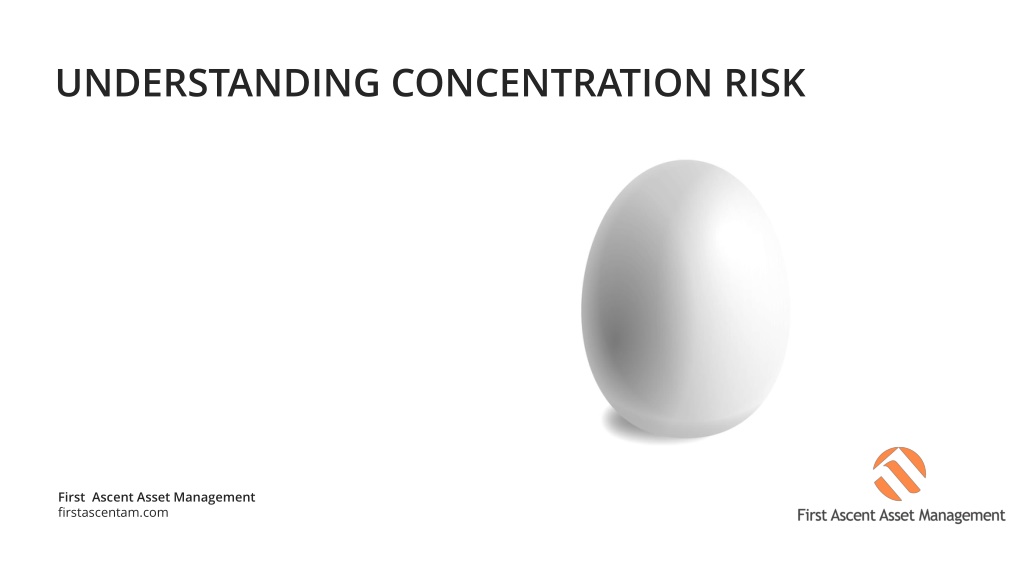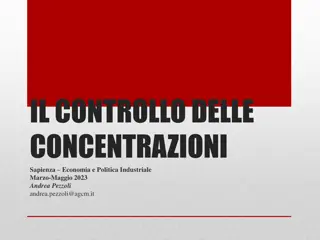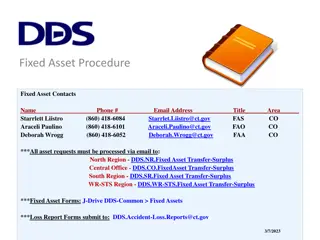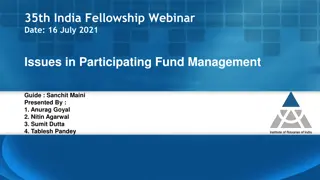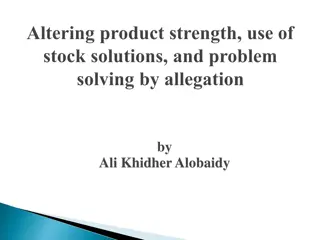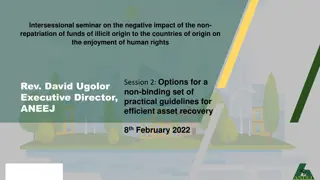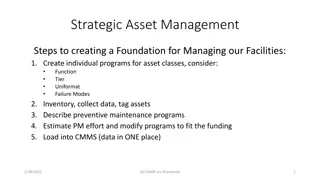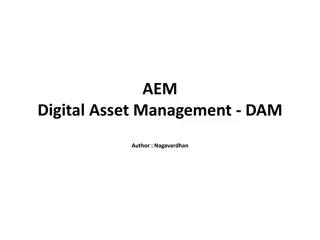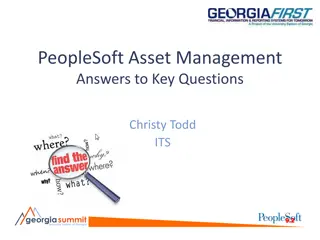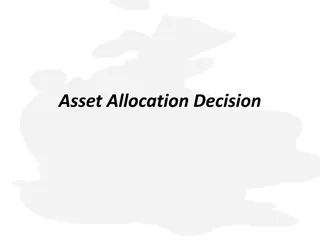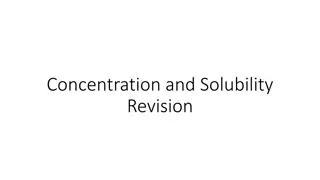Understanding Concentration Risk in Asset Management
Holding a large, concentrated stock position can be risky due to higher volatility, lower long-term returns, and increased likelihood of significant declines. Idiosyncratic risk relates to specific company factors, while systemic risk is market-related. Diversification is key to mitigate these risks. Research from Northern Trust emphasizes the advantages of investing in a broadly diversified portfolio compared to owning individual stocks.
Download Presentation

Please find below an Image/Link to download the presentation.
The content on the website is provided AS IS for your information and personal use only. It may not be sold, licensed, or shared on other websites without obtaining consent from the author. Download presentation by click this link. If you encounter any issues during the download, it is possible that the publisher has removed the file from their server.
E N D
Presentation Transcript
UNDERSTANDING CONCENTRATION RISK First Ascent Asset Management firstascentam.com
UNDERSTANDING CONCENTRATION RISK Executive Summary Holding a large, concentrated stock position comes with significant risks: A high likelihood that the concentrated position will be significantly more volatile than a broadly diversified portfolio. A high likelihood that the long-term return of the concentrated position will be lower than the return of a broadly diversified portfolio. A higher likelihood that the concentrated position will experience a very serious decline in value (-50% or more), or even a complete loss, than for a broadly diversified portfolio. Broad diversification can reduce or eliminate these risks. Therefore, unless an investor has compelling reasons to maintain their concentrated position, the investor should liquidate that position and reinvest in a broadly diversified portfolio.
UNDERSTANDING CONCENTRATION RISK Two Types of Risk Idiosyncratic Systemic Idiosyncratic risk is the risk associated with specific companies. For example, a firm may be subject to risks associated with regulatory changes, obsolete products, bad management decisions, weak financials, environmental disasters, fraud, or unforeseen events. These risks may cause a firm s stock to decline in value even if the overall stock market is doing well. Systemic risk is different. It is the risk an investor assumes by investing in the stock market. Historically, the stock market rises and falls over time. Even the stocks of healthy, well-run companies rise and fall as these market cycles repeat. There is no amount of diversification that can eliminate the impact of these up and down cycles. But over time, investors are compensated for the risk of having to experience these cycles because the stock market rises in value over the long-term. Idiosyncratic risk can be diversified away. That is, as an investor adds more stocks to their portfolio, the company-specific risks associated with any one of them become less significant. Eventually, if an investor adds enough stocks to the portfolio, those risks disappear.
UNDERSTANDING CONCENTRATION RISK Examining the Research Northern Trust In July 2019, Northern Trust published research illustrating the potential risk of owning a single stock versus the Russell 3000 index. First, they examined the volatility of those stocks. Exhibit 1 below, shows that the median stock in the index had a volatility of 46.1%, three times higher than the 14.8% volatility of the index. Only 0.2% of the stocks in the index had a volatility that was lower than that. An investor holding almost any stock in the index could reduce volatility simply by investing in a Russell 3000 index fund. Exhibit 1 Individual Stock Volatility, 1999-2018 Source: Northern Trust Research, Morningstar, FactSet.
UNDERSTANDING CONCENTRATION RISK Examining the Research Northern Trust Exhibit 2 below, shows the distribution of annualized returns for the individual stocks. Notice that well over 10% of the stocks had negative returns of -20% or more. About 5% had negative returns of - 40% or more. Again, an investor holding one of these stocks could lock in the return of the index and avoid the possibility of one of these extreme negative events by selling the stock and investing in a Russell 3000 index fund. Exhibit 2 Individual Annualized Return, 1999-2018 Source: Northern Trust Research, Morningstar, FactSet.
UNDERSTANDING CONCENTRATION RISK Examining the Research Northern Trust Since many of the individual stocks in this sample were not part of the Russell 3000 for the full 20-year period, Northern Trust conducted Monte Carlo simulations to more precisely estimate the return possibilities of holding concentrated stock positions over the full 20-year period. Exhibit 3 below shows that two-thirds of the individual stocks in the simulations underperformed the 218.39% cumulative return (5.96% annualized) of the Russell 3000 index. Exhibit 3 Individual Stock Cumulative Return Outcomes, 1999-2018 Source: Northern Trust Research, Morningstar, FactSet.
UNDERSTANDING CONCENTRATION RISK Examining the Research Northern Trust Northern Trust performed another simulation to determine the impact that taxes might have on a decision to hold an individual stock (the Hold Scenario) versus sell the stock and diversify by investing in the Russell 3000 index (the Diversification Scenario). For purposes of the simulations, they made the following assumptions: Both the stock & the index had the same return (actual return of the Russell 3000 index from 1999-2018) The index had a volatility of 14.8% and the stock had a volatility of 46.1% (the actual volatility of the index and the median stock in the index from 1999 through 2018). The cost basis of the stock was $0. The seller paid a 20% capital gains tax upon sale of the stock. They found that the median return for the Diversification Scenario was higher by the end of the fourth year than for the Hold Scenario. In other words, it paid to diversify, even after paying taxes. The improved performance made up for the taxes paid after a relatively short period.
UNDERSTANDING CONCENTRATION RISK Examining the Research Northern Trust It is also worth noting that in the worst 5% of the simulated outcomes, the Hold Scenario showed the value of the stock going to zero after four or five years. The Diversification Scenario eliminated the risk of the portfolio ever going to zero value. This suggests that in most cases, selling a concentrated stock position and diversifying makes sense. The exception might be if there would be significant taxes to pay on the sale of the stock and there is an expectation that the stock may be gifted or bequeathed in the near future.
UNDERSTANDING CONCENTRATION RISK Examining the Research Cambridge Associates Cambridge Associates examined the annualized volatility and returns of the S&P 500 Index and its individual stock components for the 10 years ending June 30, 2013. They concluded: Single stocks, on average, are about 68% more volatile than a diversified portfolio Only 8% of the individual stocks in the index had lower volatilities than the index itself. Cambridge Associates also found that diversification reduces the risk of very poor returns. During a period when the index had a cumulative return of almost 100%, more than one in ten of the index components delivered a cumulative return of -50% or worse. Many more dropped more than 50% from their peak value at some point during the 10-year period.
UNDERSTANDING CONCENTRATION RISK Examining the Research Crittenden and Wilcox In their book, The Capitalism Distribution, Eric Crittenden and Cole Wilcox explored the question of just how few individual stocks would be winners relative to a diversified index. They studied the Russell 3000 index for the period 1983 through 2006 and found: 39% of the individual stocks lost money 18.5% of the stocks lost at least 75% of their value 64% of the stocks underperformed the Russell 3000 25% of the stocks were responsible for all the gains of the index
UNDERSTANDING CONCENTRATION RISK Examining the Research Bessembinder Professor Hendrik Bessembinder s paper, Do Stocks Outperform Treasury Bills, documents that the best-performing 4% of stocks explain the entire net gain for the US stock market between 1926 and 2016. The other 96% of stocks collectively matched the performance of one-month Treasury bills and most of those lost money.
UNDERSTANDING CONCENTRATION RISK Examining the Research Morningstar John Rekenthaler of Morningstar updated Bessembinder s findings by evaluating the performance of the individual components of the Morningstar U.S. Stock Index for the 10 years from 2011 through 2020. Over this period the index produced a 13.9% annualized gain. Rekenthaler found: Only 42% of the stocks in the index posted any gain over the 10-year period Over one-third, 36%, posted a loss for the 10-year period The other 22% simply vanished from the index, being either acquired or delisted
UNDERSTANDING CONCENTRATION RISK Now You See It, Now You Don t. The research shows that relatively few stocks drive the performance of an index. Determining those that drove performance in the past is easy. Selecting those that will drive future performance is not. It is hard to foresee the forces that will impact today s high-flyers. Of the top 10 stocks in the S&P 500 index today, only one Microsoft was in the top 10 in 2000. Of the top 10 in 2000, only three Exxon, General Electric, and Walmart were in the top 10 in 1990. Half the top 10 in 1980 were oil companies. In today s top 10 there are none.
UNDERSTANDING CONCENTRATION RISK Now You See It, Now You Don t. Dimensional Fund Advisors From 1927 to 2020, the average annualized return for top-10 stocks over the three years before they became top-10 stocks was almost 25% higher than the return of the market itself. For the three years after joining the top-10, the edge was less than 1%. In the subsequent five years, on average, those stocks underperformed the market. AVERAGE ANNUALIZED OUTPERFORMANCE OF COMPANIES BEFORE AND AFTER THE FIRST YEAR THEY BECAME ONE OF 10 LARGEST IN US 1927-2020 Source: Dimensional Fund Advisors.
UNDERSTANDING CONCENTRATION RISK Now You See It, Now You Don t. Here is a sample of formerly top brands that went bankrupt and/or no longer exist: Airlines: Pan Am, TWA, Braniff, Eastern, Midway, Swissair, Sabena Automotive: Pontiac, Oldsmobile, DeLorean, American Motors, Chrysler Electronics/Photography: Polaroid, Eastman Kodak, Minolta, Circuit City, Radio Shack Energy: Enron, Texaco, Pacific Gas & Electric, Chesapeake Energy Entertainment/Media: Borders Books, Blockbuster Video, Ringling Bros. Circus Retail: Pier 1, Toys R Us, Woolworth s, JC Penney s, Sears, Brooks Bros., Nieman Marcus Technology: Compaq, Magnavox, Palm, Napster, Wang Laboratories, Pets.com, Netscape The S&P 500 index returned 18.4% in 2020 on a total return basis. Just three stocks Apple, Amazon, and Microsoft accounted for 53% of that return. If you took just the top 30 stocks by market cap out of the index, the S&P 500 would have fallen 0.03% for the year. Anticipating the prospects of a stock and picking one of the handful that drives performance is very difficult. Staking one s financial future on one s ability to do so is imprudent. The risks associated with a concentrated portfolio can be reduced through proper diversification.
UNDERSTANDING CONCENTRATION RISK The Message Is Clear Investors who want to improve their odds of reducing volatility, increasing returns, and avoiding catastrophic loss should invest in a diversified portfolio, not a concentrated position. The exceptions to this include: There are regulatory reasons why the investor must hold the position The investor must hold the position to maintain corporate control The investor has specific knowledge and is very certain the position will outperform The position has significant embedded capital gains, and the investor expects to dispose of the position in the very near future through gift or bequest. Otherwise, it is advisable for an investor holding a concentrated position to sell it and reinvest the proceeds in a broadly diversified portfolio.
First Ascent Asset Management firstascentam.com
